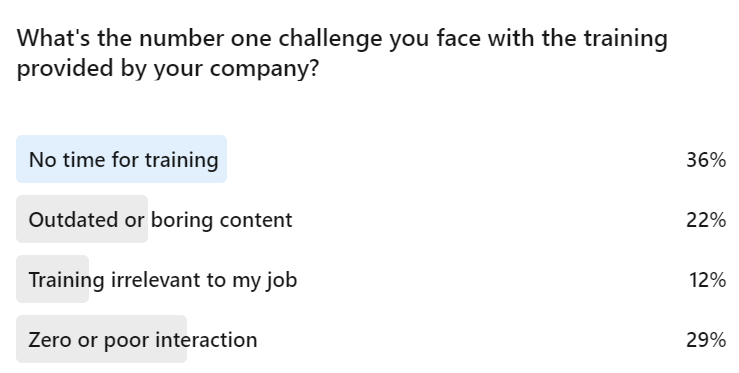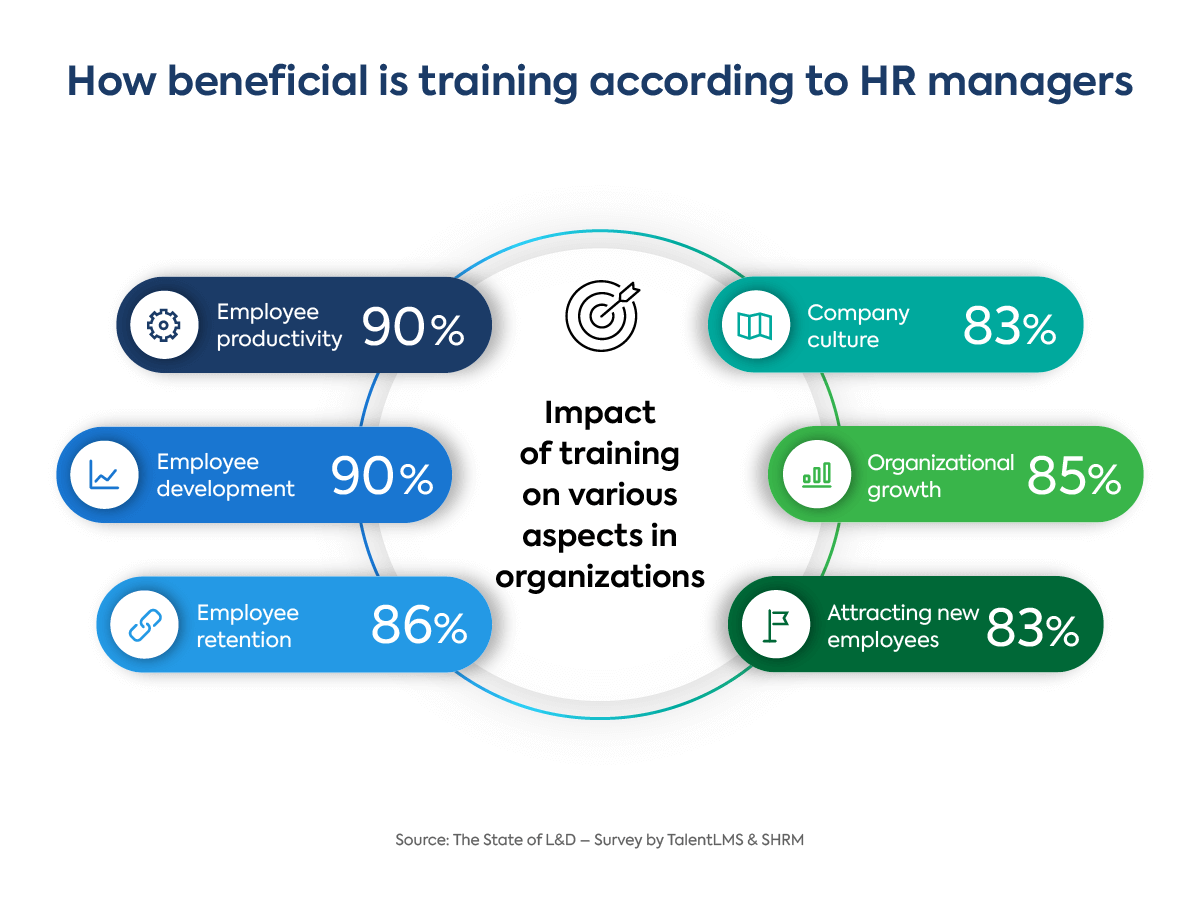Effective employee training is essential for your organization. And your people. It reduces employee turnover while driving productivity, boosts the creation of a healthy working culture, and helps your employees feel strong and confident to give their best self and reach their fullest potential.
Due to remote/hybrid work models that are here to stay, it’s necessary to examine the evolution of the workplace but also the expectations of your employees in the new norm. This means focusing on how your L&D will develop in the digital age.
Employee training is not as simple as getting your people in a conference room, giving them a lengthy lecture, and expecting them to absorb the knowledge and put it into practice. Traditional learning can’t offer your employees the same benefits it did some years ago. The concept that it can is why some organizations find themselves across employee training challenges.
As a result, companies still find their training to be ineffective (or only partially effective) in achieving their goals. This is usually because of a few common training and development problems. These training challenges range from a time-poor and sometimes dispersed workforce to limiting costs while improving engagement and catering to diverse learning preferences.
Fortunately, Moliere was right when he said, “The greater the obstacle, the more glory in overcoming it”! So, we’re going to address the most common employee training challenges and offer simple solutions to improve the effectiveness of your training.
Employee training challenges and solutions: Learners
Employee training programs have always been a necessity—even more so in this post-pandemic, hybrid work world. But how do employees actually feel about it? What training challenges are they facing? And are they happy with the training they’re getting?
A 2022 TalentLMS and SHRM survey on the state of L&D showed that among employees who have received training from their current company, 75% are satisfied with it. While this stat is optimistic, there’s still room for improvement.
TalentLMS ran a poll on LinkedIn regarding the challenges learners face—and the responses were illuminating. Here are some of the things employees struggle the most with, and what you can do to help.

Challenge #1: No time for training
Everyone is busy. Employees have to deal with an already full work schedule, let alone navigate the possible complexities of their new hybrid workplaces and the way these changes affect their work-life balance.
Blocking time consistently in their schedule every week to focus on training may feel impossible. Yet asking them to complete their training in their free time may lead to them resisting, or even resenting the whole process.
Solution: Focus on microlearning & mobile learning
Microlearning, aka bite-sized training that consists of short videos, infographics, quizzes, and checklists, will be a game-changer for busy learners. Using a microlearning approach in your employee training programs will allow them to find time for training—as a few minutes on a daily basis is much easier to plan for than blocks of hours every week.
Also, learning things in small doses is a better fit for the brain’s working memory ability. This way, microlearning improves knowledge retention.
Mobile learning is also fundamental for your employee training and development programs. Delivering your content through an app your learners can download and have on their phones makes it infinitely easier to study or watch courses even on the go—especially when combined with microlearning.
Think about communicating several concepts at once with clever graphics. They’re a valuable time-saver for learners, as well as a welcome break from reading text in emails, reports, and newsletters.
You can also prioritize short, straightforward assessments wherever possible. This provides employees with quick opportunities for feedback on their learning progress.
Challenge #2: Difficulties understanding the content
One of the main reasons learners disengage with a training program and you end up facing training challenges is because the language used is too technical. Particularly when the subject matter is complicated, using abstract concepts or technical jargon is only going to turn learners off and decrease comprehension.
This becomes even more of a problem if your team includes non-native speakers, who already face more challenges understanding jargon, acronyms, and buzzwords.
Another aspect of this is that different people learn differently. Many of your employees may have difficulties processing long stretches of text and prefer getting their content in video format—or vice versa.
Solution: Use plain language & a variety of materials in training
Using plain language in training makes the content more accessible to everyone, and saves your learners time and effort. If the language used is simple, they are more likely to understand what they read (or hear) the first time around, without having to go back and decode it.
They’re also likely to remember it better.
Another way to aid comprehension and memory retention is to cater to your learners’ learning habits by providing a variety of content types. From videos and instructor-led training sessions to quizzes, infographics, and PDFs.
You could also run a survey before (and after) for learners to pinpoint which content formats work for them and which don’t.
Also, remember these tips when planning content delivery:
- Conduct a thorough needs analysis that focuses on identifying the learning preferences (especially relating to comfort with technology) of your audience. Use the findings to inform your training design.
- Choose software with a simple, user-friendly interface (UI). A seamless user experience is good for all learners, not only those who struggle with technology. For example, pausing a video or downloading an assignment should always be straightforward and easy.
- Open up communication channels (including tech support). Use tools like discussion forums to make it easy for all learners to ask questions and receive both content and technical guidance.
Looking for an eLearning platform for seamless User Experience?
Make training user-friendly in no time with TalentLMS.
The training platform that users consistently rank #1.
Challenge #3: Can’t see how training is relevant
It happens more often than you’d think. You could be teaching something as critical as cybersecurity training or sexual harassment training. Yet, your employees may fail to see how it translates to their day-to-day work.
This doesn’t mean they don’t care about the subject matter—or that they don’t want to get better. It means that your content may come off as too generic, outdated, or simply not relevant to them.
Many training programs are too generic and not personalized enough for specific roles or skills. Unfortunately, generic training can strain learners’ time and patience by forcing them to engage with content that simply isn’t relevant to them. You can bet this leads to further training challenges.
Solution: Use relatable scenarios and clear outcomes
Learners need the content to be actionable. Even when dealing with complicated concepts, to begin with, it’s vital that you “translate” this into real-life scenarios that your employees could feasibly encounter in their day-to-day.
Whether it’s through short animated videos that showcase best practices or hands-on quizzes, bringing the content down from the sphere of the abstract to the realm of everyday life will make all the difference.
Categorize learning outcomes into essential and nice-to-have for each role undergoing training. Only make essential training compulsory, but use other methods like gamification through rewards, badges, and points to encourage learners to engage with nice-to-have content.
You should also focus on making learning outcomes clear from the get-go and stay clear from employee training challenges: make a list of key takeaways learners will get after completing the course and ensure they’re often featured within the content (perhaps after the completion of a module or before starting a new one).
Another best practice is leveraging just-in-time training for updating skills or conveying new information when needed. Relatable case studies and scenarios can also reinforce the relevance of the training program to employees’ jobs.
Last but not least, don’t forget to conduct post-training feedback surveys to discover what appeals most to learners and where your training program needs refining.

Challenge #4: The training process feels lonely and boring
Self-paced training can be hard—especially nowadays when hybrid work environments have increased feelings of isolation for many employees. When asked what would make training more effective, 32% of the TalentLMS and SHRM survey respondents said that making it more social would improve its efficacy.
And it makes sense. People learn better together.
Solution: Add gamification & social elements
Gamification has been used for years, but now is perhaps more important than ever. Learning together with their colleagues will help your employees feel like a part of a team. And gamification elements such as points, leaderboards, and badges can help achieve that in a stress-free way.
Apart from creating friendly competition, gamification is known to help with engagement. As this TalentLMS survey shows, 89% of employees agree that gamification makes them more productive, and the same number of people would be more willing to spend time in a training software if the training was gamified.
Use discussion forums and other informal live online spaces for learners to interact casually. This encourages learners to engage emotionally with other learners and the training process.
Establishing an active learning culture and making all employees feel like a part of that culture can boost emotional engagement. This emotional investment leads to increased learning and is a great way to overcome multiple employee training challenges with a single LMS feature.
Challenge #5: Dispersed workforce
A steady rise in remote/hybrid work and a decentralized workforce has led to new training challenges.
With a geographically dispersed workforce, training can be quite hard: misunderstandings are common, and cultural differences may even lead to inconsistent training. For example, some cultures are less comfortable with being vocal on online forums than others.
The solution: Use tools to bring your remote workforce together
Using tools like video conferencing, webinars, discussion boards, social media, and communication channels can help foster trust and empathy between your teams no matter where they are located. Training becomes much more effective as it helps clarify communication–discussion boards, for example, can be used as a safe space to voice questions or concerns, or share experience and knowledge.
What’s also helpful is to set clear training goals from the beginning. Team members must know exactly what is expected of them during training, and how their learning achievements will benefit them in their day-to-day tasks. Communicating the importance of each training session is vital, as employees (especially those who work remotely) don’t just get a random “complete your training” notification. You can spread the word by sending emails to your employees before, while, and after training to keep them engaged!
Employee training challenges and solutions: L&D professionals
While many of the training challenges when building your employee training programs are actually learner-facing, there are some internal challenges for your L&D team as well.
Challenge #6: Not enough bandwidth to put a training program together
Companies are beginning to realize the importance of L&D teams. The recent TalentLMS and SHRM survey showed that over half of responding HR managers plan to provide their employees with upskilling (59%) and reskilling (55%) training in 2022—and a whopping 85% of them realize that training is beneficial for company growth.

Yet, all this may not solve your team’s problem in the here and now since not only the employees can face training challenges, but the instructors themselves. If your L&D team is still small (or practically non-existent) and the creation of your employee training and development programs falls on managers who are already wearing many different hats, all the good intentions in the world won’t make up for the lack of time and bandwidth.
And while this seems like a small problem at first (you managed to set up a training program regardless, didn’t you?), it could have a ripple effect and impact the learning outcome and worsen the employee training challenges you were already facing.
For instance, if your team didn’t have enough time to find the best training content, then the course might not offer new knowledge to employees and make them feel that training was a waste of their time.
Solution: Choose some ready-made courses
Pre-made content is your friend. For industry-specific topics, you’ll need to create personalized content. But when it comes to universal skills, like communication and leadership, there’s already quality content available out there.
For instance, you could get access to a library of ready-made courses that covers everything from soft skills to sales & marketing training essentials to project management and HR essentials.
Meet TalentLibrary™
A growing collection of ready-made courses that cover the soft skills
your teams need for success at work![]()

This will allow you to focus your limited time where it’s actually needed: creating personalized content for your company’s specific needs.
Challenge #7: Can’t find the right SMEs
This training challenge may not arise often, but when it does, it can derail your whole process.
Let’s say you want to cover a specific subject, that’s either too industry-specific or too time-sensitive. And you need a Subject Matter Expert to deliver a presentation or assist you with creating engaging content.
Online learning has simplified the process a lot. When it comes to instructor-led sessions, for instance, your SME can join via Zoom from their own living room versus you having to book a conference place and invite them. That being said, you may not always be able to find the right person for the job, especially if time is of the essence. Or, you may need an SME to be more involved in the overall process of designing your course.
Solution: Involve employees in the course creation process
Have you thought about all the talent you may already have at your disposal? Talent you may not be tapping into? Some of your employees may have particular experience in one area that you may not know about. So, involving them in the course development process, even in a limited or one-off capacity, could be a great way to have an in-house SME. Wouldn’t it be great for your people to be able and help your organization with the employee training challenges that it is facing?
The only way to do this is simply to ask. You can send out a survey to your whole company quizzing people about their level of knowledge on X, Y, or Z subject matter. Or, you can reach out to team managers and ask for their feedback. They’ll probably know if someone on their team has the expertise you’re looking for.
You can (and should) of course, offer employees some incentives, monetary or otherwise. But you may also be surprised by how passionate people can be and how willing to share their knowledge, when it comes to a subject matter they know well and is important to them.
Challenge #8: Running on a very tight budget
No matter how you slice it, creating employee training programs costs money. In fear of an upcoming recession, one of the most common training challenges is the lack of an available training budget.
Even with online training removing many costs (such as venue hire, travel expenses, etc.), you still need equipment for videos, money to buy software, and the hours of everyone involved in the process that needs to be compensated.
How do you swing all that without sacrificing quality?
Solution: Find a cost-effective or free LMS
Online training doesn’t have to break the bank. Look for a solution that covers your specific needs and employee training challenges instead of investing in an expensive platform with features you’ll never use.
For example, you might want to focus on software that allows you to easily drag and drop content. This way, you’ll be able to create courses in just a few clicks by repurposing existing material. Or, if you train a multilingual audience, you should prioritize getting an LMS that allows you to customize the look and feel of your portal and use different languages to address different groups.
Once you’ve identified your needs, compare your options. It might be best to start with a free LMS or one that has flexible pricing plans, so you can test whether it’s working for you and your teams before making a larger commitment.
Employee training and development programs are living things
And as such, they will always be evolving. So, even though the future will surely bring new employee training challenges, the important thing is to approach training with the right mindset. It’s not just a box to tick but something that brings real value, both to your employees and your company.
At the end of the day, training is not about completing a course, but about learning new skills and knowledge—and this is a journey that can, and should, always be optimized.
Originally published on: 11 Apr 2018 | Tags: Employee Training,learning and development,training and development



